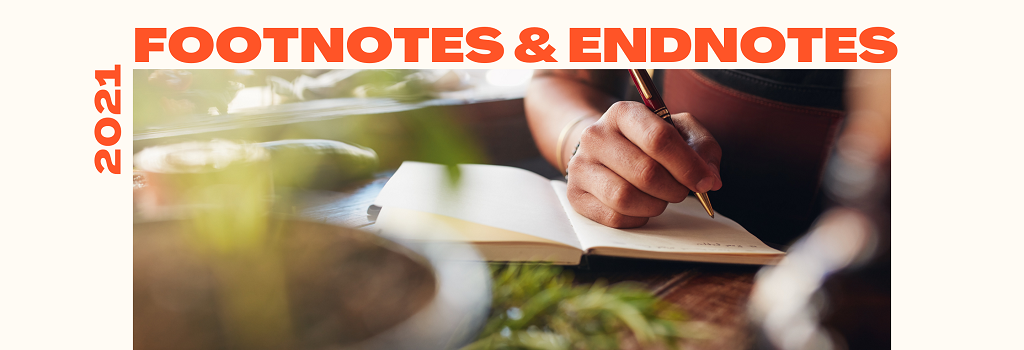Simple Guide on Academic Citations Your Footnotes and Endnotes

References in your paper writing are as important as your point of view. When you touch a complex, ambiguous subject, researchers will want to see where you have gotten this information. Based on the individual analysis, they can trust or discard the essay and your following works.
The best way to understand citing is to follow the guide while reading sources. Notice what particularly they’re explaining and why, and whether they’re too extensive, scarce, or just enough for your opinion. Or use this article as a FAQ to the most common student questions when it comes to putting in sources.
Footnotes or Endnotes?
This concerns the niche you’re writing in, the style you’re using, and the instructor’s preferences. In history and law sciences, footnotes are traditionally preferred over the reference list in the end. It is different for social, medical, and natural studies.
Don’t mistake them for reference pages. A bibliography is an alphabetic list of works you have used. The function of notes is to take papers from that list and indicate where exactly you have used them. Also, bibliographies can contain sources you’ve been inspired by while writing an essay but haven’t included, so you can’t substitute one chart with another.
However, there is no difference between end notes and footnotes themselves. You don’t need to use both methods at the same time, if only your professor asks for it. But now we will clear difference between footnotes and endnotes in details.
What are the Pros and Cons?
Both footnotes and end noteshave their defenders and skeptics. People who cite beneath each page believe it makes the reading a lot more productive. The reader can switch their look to the bottom and know more about what they have just read. With endnotes, it takes time to connect the sentence with the reference, especially within a lengthy list of attachments.
On the other hand, those who prefer to fill the last pages are afraid that long footnotes can actually spoil the reading. The only available small font size is positioned as another reason against them. On the contrary, end citations organize the space and allow writing bigger notes.
What Information to Cite?
Take as a rule: better frequent than rare. In other words, you can skim through dozens of articles on this topic but find no ready answer. That is because each case requires an individual approach. Beneath, you will find directions that will help you to make the right decision.
- Cite new information
When analyzing primary or secondary sources, always highlight what was new to you. This requires a special mention in most cases.
Nevertheless, estimate the value of the information for your colleagues: this fact might be widely known in your field. For example, a formula of Einstein will require a notion less likely than a recent formula from a modern physicist, even when you have found them out on the same day.
- Cite theories and hypotheses
Unlike stable knowledge, theories need to have their clear origin, no matter how popular they are. The statement that glaciers thaw rapidly because of human activity needs to be supported, though people talk about it everywhere.
Taking opinions for granted, you have a strong risk of ending up in bias and crossing all your precious effort. So double-check and give your readers the same opportunity.
- Cite experiments, approaches, methods
Don’t cite what was proved centuries ago unless you describe the process of researching the subject or share specific results. For example, it’s obvious the Amanita mushroom is poisonous to humans. But that it takes only 30 grams to kill? Readers would like to know about experiments, observations, and statistics that support this opinion—and a single reference to the work could be enough.
- Cite uncommon opinion
If you’re talking about a point of view that for some reason is not supported by an authoritative community, give your visitors more information. They include psychological and medical practices like psychosomatic, conspiracy theories, curious views on popular historical events, and so on similarly. Describe whatever deviates from people’s established comprehension of things.
- Cite authors’ statements
Obviously, a quote must be addressed to a certain person, as well as a paraphrase. Without a clearly stated person, the saying loses its persuasiveness and seems fabricated. If you have a good phrase but don’t know the speaker, either find them or, sadly, let it go.
How to Organize Citations?
It depends on the style and field of study, but usually doesn’t cause trouble. At the end of a sentence, part of a sentence, or block that, in your opinion, should have a reference, you put a digit. A subsequent sentence or block must bear an n+1 higher number.
That means you can’t refer to one number twice, even if you’re talking about one research paper. By the way, using a number of multiple times is allowed in the Vancouver referencing system.
A digit can be in superscript, in square or round brackets in compliance with the style. The same is true for references, but you put a number before a footnote or endnote.
Citing is a monotonous process where people are prone to errors. These mistakes are usually about breaking the sequence of numbers or putting them twice. Formatting and correct notes are other things you may want to double-check. References are the endoskeleton of your research, so don’t be lazy to devote a bit more time to them!
